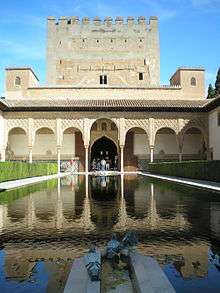Court of the Myrtles

The Court of the Myrtles (Patio de los Arrayanes) is part of the palace and fortress complex of the Alhambra. It is located east of the Gilded Room (Cuarto Dorado) and west of the Patio of the Lions and the Baths. Its current name is due to the myrtle bushes that surround the central pond and the bright green colour of which contrasts with the white marble of the patio. It was also called the Patio of the Pond or the Reservoir (Patio del Estanque o de la Alberca) because of the central pond, which is 34 metres long and 7,10 meters wide.[1] The patio is divided in two sides by the pond, which receives its water from two fountains. The space has chambers and porticoes around it. These porticoes rest on columns with cubic capitals, which have seven semicircular arches decorated with fretwork rhombuses and inscriptions praising God. The central arch is greater than the other six and has solid scallops decorated with stylised vegetal forms and capitals of mocarabes.
The most important chambers that surround the Patio are the ones in the north side, which are part of the Comares Palace, the official residence of the King.
Comares Palace
The name of the Palace, Comares, has led to various etymological research. For instance, Diego de Guadix wrote a dictionary about Arabic words in which it is said that Comares originally comes from cun and ari. The first term means stand up and the second one look, in other words it would have meant Stand up and look around or possibly Open your eyes and see, which is a way of referring the beauty of the place.[2]
In the sixteenth century, a historian from Granada called Luis de Mármol Carvajal claimed that the term Comares derived from the word Comaraxía, that actually has a meaning related to a craftsmanship labor very appreciated by Muslims: a manufacturing technique of glass for exterior and ceilings.[3]
A third suggested theory is that the name comes from the Arab word qumariyya or qamariyya. These ones designate the stained glasses that can even be glimpsed from the Hall of the Ambassadors' balcony.[4]
There's another possibility that says that Qumarish is the name of a region in the North of Africa where most craftsmen came from, in other words, the place might be called Comares in honour of the people who worked there.[5]
See also
References
- ↑ "Court of the Myrtles". Alhambra de Granada.
- ↑ Guadix 2005: p. 551
- ↑ Pijoán 1954: p. 516
- ↑ Irwin 2003: p. 36 Cfr: Sánchez Mármol, in his book Andalucía Monumental (Granada 1985)
- ↑ James Dickie, expert on the Alhambra
Bibliography
| Wikimedia Commons has media related to Patio de los Arrayanes (Court of the Myrtles). |
- Robert Irwin (2010). La Alhambra. Granada: Almed. ISBN 978-84-15063-03-2.
- José Pijoán (1954). Historia general del arte, Volume XII, Summa Artis collection. Islamic Art. Madrid: Espasa Calpe.
- Diego de Guadix (2005). Compilation of some Arabic names that the Arabs put to some cities and many other things. Edition, introduction, notes and index: Elena Bajo Pérez y Felipe Maíllo Salgado. TREA Editions. ISBN 84-9704-211-5.
- Washington Irving (1970). Tales of the Alhambra. Aguilar. Legal deposit BI. 1285,1970.